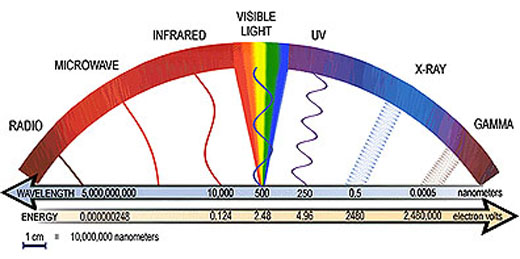Q and A of the Day: What is electromagnetic radiation?
Q: What are the different types of electromagnetic radiation and what are they used for?

A: There are many kind of electromagnetic radiation (EMR) and they are distinguished by their wavelengths if you consider EMR as waves.
You can also think of electromagnetic radiation as consisting of particles of light, called photons, and each photon has a certain amount of energy associated with it. Each energy corresponds to a different type of EMR. High-energies correspond to short wavelengths.
Let's think of EMR as waves for our discussion. Scientists group together certain wavelengths into categories, for example visible light is the group of wavelengths from 400 nanometers to 700 nanometers. This is the energy band (or grouping) that our eyes are sensitive to.
An example of longer wavelength EMR is the group we call radio waves, which are familiar to you from listening to the radio. Shorter wavelengths are grouped together as ultraviolet radiation, the band that gives us sunburns! And even shorter wavelengths are grouped together as X-rays. X-rays can be used in many different ways, but two of the most important ways are medical X-rays and X-ray telescopes like Chandra.
For a medical X-ray, a beam of X-rays is sent towards a human being (let's say towards a tooth) and a special plate is set behind the tooth to catch the X-rays after they pass through. This gives a picture of the tooth including any cracks or cavities in it. So it is a type of X-ray picture. (You can find more explanation of this and an illustration at http://chandra.harvard.edu/xray_astro/medxray.html)
X-ray telescopes, on the other hand, are big X-ray buckets, catching X-rays that are emitted from objects in the universe. Since X-rays have short wavelengths, and therefore high energies, telescopes like Chandra are most sensitive to hot (high energy) objects and processes. For more information on this works, go to http://chandra.harvard.edu/xray_astro/xrays.html
Please note this is a moderated blog. No pornography, spam, profanity or discriminatory remarks are allowed. No personal attacks are allowed. Users should stay on topic to keep it relevant for the readers.
Read the privacy statement
